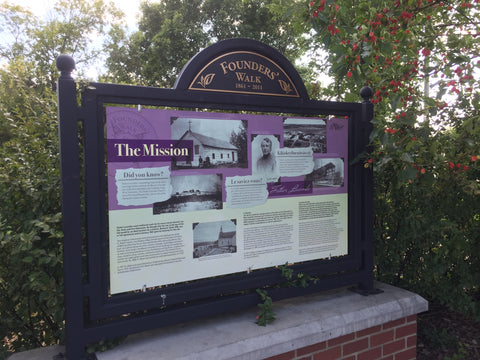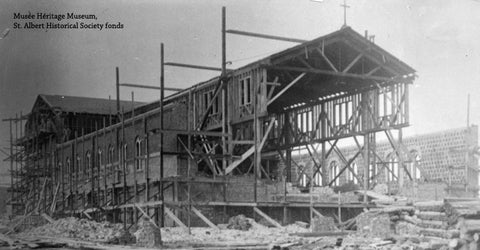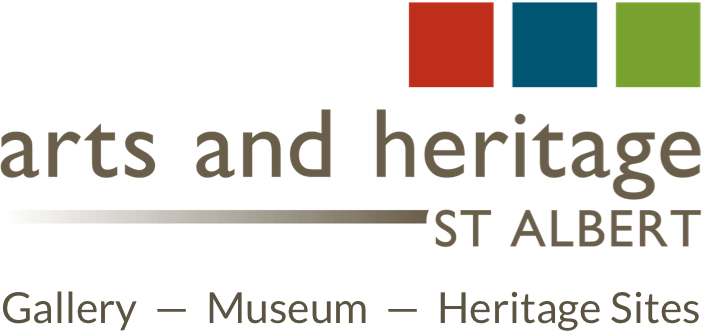

ONLINE EXHIBITION
11. The Mission
The Mission
Father Lacombe used traditional trails for his many travels between Lac Ste. Anne and Fort Edmonton. He thought that the site at the top of this hill would be an ideal location for a mission. Bishop A. Taché, OMI, was in full agreement and in January 1861 gave his blessing for this site.
Two religious communities were instrumental in the development of the St. Albert mission: the Oblates of Mary Immaculate and the Sisters of Charity of Montreal (the Grey Nuns). Not only did they offer spiritual guidance, they built and administered churches, schools, hospitals, orphanages and seniors’ facilities. At its height, the Mission included church buildings and residences, as well as farming operations run by the Oblates and Grey Nuns, a blacksmith’s shop, carpentry shop, laundry, and honey storehouse. The Catholic Church actively recruited settlers and other missionaries to support the growth of the community. By 1888, St. Albert had reached an estimated population of 1,000.
In 1871 St. Albert was given the honour of becoming a Roman Catholic Episcopal See. In 1912, the Diocese of St. Albert was relocated and elevated to the new Archdiocese of Edmonton.
La Mission
Lors de ses nombreux voyages entre Lac Ste-Anne et Fort Edmonton, le Père Lacombe remarqua que l’endroit au sommet de la colline, près de la rivière Esturgeon serait idéal pour bâtir une mission. Monseigneur Taché, OMI acquiesça à sa demande et en janvier 1861, lors d’un séjour dans la région, il donna sa bénédiction au nouvel emplacement.
La mission de St-Albert s’est développée grâce au dévouement de deux communautés religieuses : les Oblats de Marie Immaculée (OMI) et les Soeurs de la Charité de Montréal (les Soeurs Grises). Non seulement ces communautés ontelles offert un accompagnement spirituel, elles ont aussi construit et administré des églises, des écoles, des hôpitaux, des orphelinats et un hospice. À son apogée, la Mission incluait plusieurs bâtiments religieux, des résidences, deux immenses fermes, une forge, une menuiserie, une buanderie et un entrepôt de miel. C’est surtout grâce à l’Église Catholique, qui était continuellement à la recherche de colons et d’autres missionnaires, que la communauté s’est développée. En 1888, la population de St-Albert était estimée à 1,000 personnes.
En 1871, St-Albert est devenu le siège épiscopal catholique romain. En 1912, le diocèse de St-Albert a déménagé à Edmonton, s’élevant par la même occasion au rang d’archidiocèse.
Father Lacombe kâkîhitiht, kayâs meskanâsa kîpimitsaham, kâkîmânôma papamohtet, ôte ohci Lac Ste Ann (secân sâkahikanihk) Kîmiskam piyisk ispacinâs ita ehiteyihtahk tamiywâsiniyik tacimateyik ayamihewikamik. Kîkakwecimew kihcihayamihewiyiniwa Bishop A. Tache O.M.I., ehisiyihkâsoyit, tapakitinamâkot tôtinasket ekota tacimatât ayamihewikamik. Metoni kîcîhkîstamwak, kîsîhkimik ekota ayamihewikamik tamacihtâyit ewako pipon Kisepisim 1861. Macika kîyosihcikâtew ayamihewikamik Opâhkwâyimihâwak ohci.
Ayamihewiyiniwak Oblates of Mary Immaculate ehisiyihkâsocik, ekwa ayamihewiskwewak Sisters of Charity of Montreal ehisiyihkâsocik kîmisiwîcihtâsowak epasikônahkik ayamihâwin ekwa ayamihâw pimâtisowin ayâmihewînînâhk St. Albert. Namoya piko ayamihâwin mâka mîna ekîcimatâcik ekwa epaminahkik ayamihewkamikwa, ekîpimipayihtâcik kiskinohamâtowikamikwa, ahkosiwikamikwa, kîwâci awâsisiwikamikwa, ekwa ita kakanaweyimihcik kihteyak kawîkihîcik. Emekwâpasikônikâtek ayamihâwisihcikewin ayamihewikamikohk ekwa kotakihk wîkowinwa, ekîpimipayihtâcik kistikewin, mistatimomaskisinihkewikamik, mistikowiniwikamik, okisîpekinikewikamik, ekwa âmômeyokamik. Pâhkwayimihewiyiniwak kînitomew otôtinaskewa ekwa kotaka otayamihâwa kawîcihikocik, tamâmawinitocik tayâhkimotâcik St Albert ekospî 1900 ehispayik nânitaw 1,059 ekîhihtakocik ayisiyiniwak.
Ekospî 1871 St. Albert ekîkihcitawakeyihtamihk ekota takanaweyihtamihk Pâhkwayamihâw sîhcikewina ekwa kihcihayamihewiniw isko 1912, ekwa ekota ohci kîhispicitakwan Archdiocese Amiskwacîwâskahikanihk ici.



